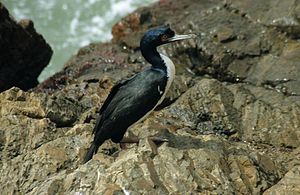Guanocormorant
This article has been registered in the quality assurance biology for improvement due to formal or content-related deficiencies . This is done in order to bring the quality of the biology articles to an acceptable level. Please help improve this article! Articles that are not significantly improved can be deleted if necessary.
Read the more detailed information in the minimum requirements for biology articles .
| Guanocormorant | ||||||||
|---|---|---|---|---|---|---|---|---|

Guanocormorant ( Leucocarbo bougainvillii ) |
||||||||
| Systematics | ||||||||
|
||||||||
| Scientific name | ||||||||
| Leucocarbo bougainvillii | ||||||||
| ( Lesson , 1837) |
The guanocormorant or guanoshark ( Phalacrocorax bougainvilliorum , Syn . : Phalacrocorax bougainvillii , Leucocarbo bougainvillii , protonym Carbo Bougainvillii ) is a very large bird in the cormorant family . In South America he is one of the most important guano producers.
features
He reaches a height of 71 to 76 cm. The head, neck and top are glossy greenish-black in color, while the chin and the underside under the neck are white. The face is featherless and the skin of the face is colored red, while the feet are pink. It has a patch of white feathers above each eye. The beak is yellow and the webbed feet are red. The wingspan is 1 meter.
distribution
The guanocormorant is found on the western coast of South America from Peru to the south. He inhabits the offshore smaller island and rocky cliffs.
Way of life
This species feeds mainly on anchovies . When caught, these birds come down very quickly from the water surface into the deeper water. If an El-Nino occurs and there are no schools of fish, the population of the species declines sharply. The total number of animals of this species is very dependent on the anchovy population.
Reproduction
Reproduction takes place in very large colonies on the smaller islands off the west coast of South America. During the breeding season, which is not seasonal, there are up to three breeding pairs per square meter, a total of up to a million animals. The nest is a flat elevation on the Guano Mountains on the islands, which are only sparsely covered with thin branches or the like. 1-6 elongated, oval, lime blue eggs are laid. The incubation period is about a month. The young, who are nestled, are black and white in color. The young do not receive the coloring of the adult birds until they are 40–50 days old. Parents provide them with pre-digested fish. There are usually two broods per year.
use
Man has been using guano to excrete these animals since the times of the Incas . A single colony of these birds can leave behind up to 1,000 tons of guano per day. Today the harvest is strictly monitored to protect the birds and is only carried out after the end of the breeding season.
Individual evidence
- ↑ a b Guanocormorant ( Phalacrocorax bougainvilliorum ) at Avibase; accessed on March 9, 2018.
- ↑ Kirsten Stöven, Frank Jacobs, Ewald Schnug: Guano - a historical fertilizer In: Journal for cultivated plants. Volume 68, 2016, ISSN 1867-0911, p. 199, DOI: 10.5073 / JFK.2016.07.02 ( PDF file ).
- ↑ J. Orta, F. Jutglar, EFJ Garcia, P. Boesman: Guanay Cormorant (Phalacrocorax bougainvilliorum). In: J. del Hoyo, A. Elliott, J. Sargatal, DA Christie, E. de Juana, E. (eds.): Handbook of the Birds of the World Alive. Lynx Edicions, Barcelona 2018 ( online ).
literature
- Jiří Felix (ed.), Alena Čepická: America's fauna in color. Translated from the Czech by Jaroslav Konšal. Karl Müller Verlag, Erlangen 1989, book no. 1/12/05 / 52-03, pp. 153-154.
- Christopher M. Perrins (ed.): The great encyclopedia of birds. Translated from the English by Christine Barthel, Peter H. Barthel. Orbis, Munich 1996, ISBN 978-3-572-00810-0 , pp. 62-64.
- Christopher M. Perrins (Ed.): The FSVO encyclopedia birds of the world. Translated from the English by Einhard Bezzel. BLV, Munich / Vienna / Zurich 2004, ISBN 978-3-405-16682-3 , pp. 92-93 (title of the original English edition: The New Encyclopedia Of Birds. Oxford University Press, Oxford 2003).
Web links
- Leucocarbo bougainvilliorum in the endangered Red List species the IUCN 2008. Posted by: BirdLife International, 2008. Accessed January 6 of 2009.
- Videos, photos and sound recordings of Phalacrocorax bougainvillii in the Internet Bird Collection